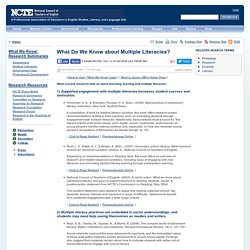

Kylie%20Smith. 26n3lynch. Critical_transdisciplinary_multiliteracies_albright_walsh. Susan hill mapping multiliteracies project. Multimodal. 'design' in multliteracies pedagogy. Multiple intelligences. Multimodality. Multiliteracies as transdisciplinarity curriculum practice. Multiliteracies_for_the_21st_Century_May_05. CJE33-2-Giampapa. Multiliteracies at newlearningonline. Expanding the Scope of Literacy Pedagogy The term ‘Multiliteracies’ refers to two major aspects of language use today.

The first is the variability of meaning making in different cultural, social or domain-specific contexts. These differences are becoming ever more significant to our communications environment. This means that it is no longer enough for literacy teaching to focus solely on the rules of standard forms of the national language. Rather, the business of communication and representation of meaning today increasingly requires that learners are able figure out differences in patterns of meaning from one context to another.
The second aspect of language use today arises in part from the characteristics of the new information and communications media. Next. A Pedagogy of Multiliteracies: Designing Social Futures. Copyright©1996 by the President and Fellows of Harvard College.

All rights reserved. A Pedagogy of Multiliteracies: Designing Social Futures Abstract In this article, the New London Group presents a theoretical overview of the connections between the changing social environment facing students and teachers and a new approach to literacy pedagogy that they call "multiliteracies. " The authors argue that the multiplicity of communications channels and increasing cultural and linguistic diversity in the world today call for a much broader view of literacy than portrayed by traditional language-based approaches. If it were possible to define generally the mission of education, one could say that its fundamental purpose is to ensure that all students benefit from learning in ways that allow them to participate fully in public, community, and economic life.
This question of differences has become a main one that we must now address as educators. Changing Working Lives. What Do We Know about Multiple Literacies? [ Back to main "What We Know" page ] [ Back to Squire Office Home Page ] What current research tells us about teaching, learning and multiple literacies: 1) Supported engagement with multiple literacies increases student success and motivation.

Hinchman, K. A., & Sheridan-Thomas, H. K. A compilation of work by leading literacy scholars, this book offers research-based recommendations related to best practices, such as motivating students through engagement with multiple literacies. . | Click to Read Abstract | Preview/Access Online | Rush L. Expanding on recommendations in Reading Next, this book offers an overview of research and related classroom practices, including ways of engaging with new literacies and promoting student literacy learning through participatory learning.| Click to Read Abstract | Preview/Access Online | National Council of Teachers of English. (2004).
Moje, E. Lenhart, A., Arafeh, S., Smith, A., Macgill, A. Multiple Literacies. Even more than multiple intelligences which we share with other language-using creatures, multiple literacies make us humans different.

We are the only creatures who use systems of marks to express meaning. These strings of marks, these literacies include drawing, writing, musical notation, and mathematical notation. Marks are brain food. Oxygen, glucose, and symbol "crunching" nourish human brains. Our brains are electrical systems: they oscillate. Our minds are designed to work in a cross-modal manner, shunting information back and forth from one mode of representation, or literacy, to another.
As very young children, we embark on the adventure of literacy through scribbling and drawing. Human literacies are multiple and varied, interdependent and equivalent, related and necessary. Literacies nourish each other. In Consilience, E.O. Why constrain the human brain to a limited range of literacies? Multipleliteraciescriticalpedagogy.